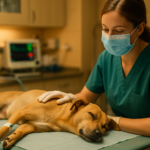
There’s nothing more heartbreaking than losing a beloved family member. Here at Slaton Veterinary Hospital, we’ve successfully reunited countless lost pets with their families thanks to one simple procedure: microchipping.
As your other family doctor, Dr. Slaton wants every pet owner in Westlake Village to understand how this life-saving technology can protect your furry family members.
What Exactly Is a Pet Microchip?
A pet microchip is a tiny integrated circuit about the size of a grain of rice. This small transponder contains a unique identification number that connects to a database with your contact information. The American Veterinary Medical Association strongly recommends microchipping as the most reliable form of permanent pet identification. According to AVMA statistics, microchipped dogs are returned to their owners 52% of the time, compared to only 22% for dogs without microchips. Unlike collars that can break or fall off, a microchip stays with your pet for life.
Here’s what makes microchips so effective:
- Permanent identification that can’t be lost or removed
- Radio frequency technology that works without batteries
- Readable by scanners at animal shelters and veterinary clinics
- Connects to national registry systems for quick owner contact
Learn more about our comprehensive pet services including preventive care that complements microchipping.
Where Do They Chip Cats and Dogs?
The microchip placement follows strict veterinary medicine guidelines established by organizations like AAHA (American Animal Hospital Association). Research shows that proper placement is crucial for scanner detection – the American Veterinary Medical Association reports that 99.7% of properly placed microchips remain detectable throughout a pet’s lifetime.
For dogs: The chip is typically implanted between the shoulder blades, slightly to the left of the midline. This site provides easy scanner access while keeping the chip secure under the skin.
For cats: Microchips are placed in the same location – between the shoulder blades. The procedure is identical whether you have a tiny kitten or a full-grown cat.
Dr. Slaton has placed thousands of microchips in pets throughout his 20+ years of practice. The consistent placement ensures that animal shelter workers and veterinary staff know exactly where to scan. For more information about Dr. Slaton’s expertise, visit our About Us page.
The Microchipping Procedure: What to Expect
Many pet owners worry about pain during the microchip procedure. The good news is that microchipping is quick and causes minimal discomfort. Studies show that 95% of pets show no adverse reaction to microchip placement.
The process involves:
- Injection using a specially designed syringe
- Quick placement under the skin
- Immediate scanner check to verify proper function
- Registry enrollment with your contact information
“The microchip injection is similar to a routine vaccine. Most pets barely notice it, and no anesthesia is required.” – Dr. Daniel Slaton, DVM
The entire procedure takes less than a minute. Many pet owners choose to have their puppy or kitten microchipped during their spay or neutering surgery, though it can be done during any regular visit.
Learn more about our surgical services including spay and neuter procedures.
Microchip Services at SVH: Beyond Basic Placement
At Slaton Veterinary Hospital, we provide comprehensive microchip services that go beyond simple placement.
Our microchip program includes:
- Pre-injection consultation about chip placement
- Pain management to ensure your pet’s comfort
- Database registration assistance
- Registry account setup and verification
- Follow-up scanner checks during routine visits
We work with major pet recovery service networks to ensure your information reaches the widest possible network of shelters and veterinary clinics. For urgent situations, check our emergency care services.
Keeping Your Information Current
A microchip is only effective if your contact information stays current in the database. According to the American Humane Association, failure to register or update microchip information is the primary reason lost pets aren’t reunited with their families. Life changes like moving, new phone numbers, or changes in ownership require registry updates.
Remember to update your information when:
- You move to a new address
- Your telephone number changes
- You travel extensively with your pet
- Ownership transfers to a family member
The SVH team can help you access your registry account and make necessary updates during your pet’s regular health visits.
Managing Your Pet’s Microchip Registry Online
Modern microchip services make it easy to manage your pet’s information through online portals. Most registry systems offer user-friendly websites where you can update details anytime.
Setting up your online account:
Create your registry profile. After microchip placement, you’ll receive information about your specific database system. Major registries include HomeAgain, Found Animals, and AKC Reunite.
Verify your unique chip number. Each microchip has a distinct identification number that connects to your account. Keep this number in a safe place along with your pet’s other important documents.
Complete your contact profile. Enter your primary telephone number, address, emergency contacts, and any special instructions about your pet’s health or behavior.Set up account notifications. Many registries offer email or text alerts when your information is accessed, providing an extra layer of security for your pet’s data.
The online update process is straightforward:
- Log into your registry account using your username and password
- Navigate to your pet’s profile section
- Update any changed information (address, phone, email)
- Save changes and verify updates appear correctly
- Print or save confirmation for your records
Most registries charge a small annual fee (typically $15-20) to maintain active services. This fee ensures your pet’s information stays accessible to animal shelter workers and veterinary clinics nationwide.
Important update reminders:
- Update immediately after moving
- Change telephone numbers within 24 hours
- Add vacation contacts when traveling
- Include any new health conditions or medication requirements
The team at SVH can assist with online registry management during your pet’s regular visits. We’ll help troubleshoot account access issues and ensure your information stays current in the database.
Pro tip: Set a yearly reminder to review and update your pet’s microchip registry information, even if nothing has changed. This ensures your account stays active and accessible.
What If Your New Pet Is Already Microchipped?
Adopted a rescue pet or purchased from a previous owner? Your new furry family member may already have a microchip that needs updating.
Here’s what to do when you acquire a previously chipped pet:
First, verify the microchip exists. Bring your new pet to SVH for a scanner check. Dr. Slaton will locate the chip and provide you with the identification number.
Contact the current registry. Each chip connects to a specific database. We’ll help you identify which registry holds your pet’s information and guide you through the transfer process.
Update ownership information immediately. Most registries charge a small fee to transfer ownership, but this step is crucial for your pet’s safety. Without proper transfer, the previous owner would be contacted if your pet goes missing.
Verify your contact details are current. Even after ownership transfer, double-check that your telephone number, address, and emergency contacts are accurate in the database.
At Slaton Veterinary Hospital, we frequently help families with rescue animals and adoption paperwork. Many pets from animal shelter facilities come pre-chipped, and we’ll ensure the transition goes smoothly.
Pro tip: Ask the shelter or previous owner for any microchip documentation. This speeds up the transfer process and helps us verify the chip’s registry information. If you’re considering adoption, check out our free first exam offer for newly adopted pets. We’ll handle the microchip verification as part of your new pet’s comprehensive health evaluation.
Common Microchip Questions from Pet Owners
Will the microchip interfere with other medical procedures? Microchips don’t interfere with radiology, surgery, or other veterinary procedures. They’re designed to be completely compatible with medical equipment.
Can microchips track my pet’s location like GPS? No, microchips use radio frequency identification only when scanned. They don’t provide real-time tracking or location services.
Do all animal shelters scan for microchips? Most animal shelter facilities and veterinary clinics routinely scan lost animals for microchips. The ASPCA reports that over 90% of animal shelters now scan for microchips as standard practice in veterinary medicine.
For additional resources about pet identification, visit the American Veterinary Medical Association’s pet identification page.
Beyond Dogs and Cats: Other Animals That Benefit
While we primarily microchip dogs and cats, the technology works for many animals. Rabbit owners, bird enthusiasts, and even wildlife rehabilitators use microchip identification. The American Kennel Club recognizes microchipping as essential for all dog breeds and mixed breeds alike.
Each animal requires specific placement techniques, and Dr. Slaton’s experience with various species ensures proper chip placement for maximum effectiveness.
Schedule Your Pet’s Microchipping Today
Don’t wait until your furry family member goes missing. Research from the Journal of the American Veterinary Medical Association shows that only 2% of lost cats without microchips are returned to their owners, compared to 38% of microchipped cats. Microchipping provides peace of mind and dramatically increases the chances of a happy reunion.
The compassionate team at SVH makes the process comfortable for both you and your pet. We’ll handle everything from chip placement to registry enrollment.
Ready to protect your beloved companion?
Schedule Your Pet’s Microchip Appointment
Call SVH at (805) 269-6696 to book your appointment today. Our knowledgeable staff will answer any questions about microchipping and help you choose the best services for your pet’s needs.
For more pet safety tips and information, explore our blog or contact us directly.Protect Your Family – Microchip TodaySlaton Veterinary Hospital: Where Your Family Becomes Our Family3900 E. Thousand Oaks Blvd Ste 101, Westlake Village, CA 91362Monday-Friday 8:00am-6:00pm | Saturday 8:00am-4:00pm




